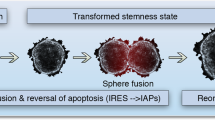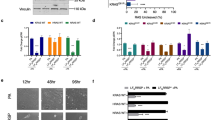Abstract
To prevent neoplasia, cells of multicellular organisms activate cellular disposal programs such as apoptosis in response to deregulated oncogene expression, making the suppression of such programs an essential step for potentially neoplastic cells to become established as clinically relevant tumors. Since the mutation of ras proto-oncogenes, the most frequently mutated proto-oncogenes in human tumors, is very rare in some tumor types such as glioblastomas and gastric cancers, we hypothesized that mutated ras genes might activate a cell death program that cannot be overcome by these tumor types. Here we show that the expression of oncogenically mutated ras gene induces cellular degeneration accompanied by cytoplasmic vacuoles in human glioma and gastric cancer cell lines. Cells dying as a result of oncogenic Ras expression had relatively well-preserved nuclei that were negative for TUNEL staining. An immunocytochemical analysis demonstrated that the cytoplasmic vacuoles are derived mainly from lysosomes. This oncogenic Ras-induced cell death occurred in the absence of caspase activation, and was not inhibited by the overexpression of anti-apoptotic Bcl-2 protein. These observations suggested that oncogenic Ras-induced cell death is most consistent with a type of programmed cell death designated `type 2 physiological cell death' or `autophagic degeneration', and that this cell death is regulated by a molecular mechanism distinct from that of apoptosis. Our findings suggest a possible role for this non-apoptotic cell death in the prevention of neoplasia, and the activation of the non-apoptotic cell death program may become a potential cancer therapy complementing apoptosis-based therapies. In addition, the approach used in this study may be a valuable way to find genetically-regulated cell suicide programs that cannot be overcome by particular tumor types.
This is a preview of subscription content, access via your institution
Access options
Subscribe to this journal
Receive 50 print issues and online access
$259.00 per year
only $5.18 per issue
Buy this article
- Purchase on Springer Link
- Instant access to full article PDF
Prices may be subject to local taxes which are calculated during checkout





Similar content being viewed by others
References
Adachi J, Ookawa K, Shiseki M, Okazaki T, Tsuchida S, Morishita K and Yokota J. . 1996 Cell Growth Differ. 7: 879–886.
Anglade P, Vyas S, Javoy-Agid F, Herrero MT, Michel PP, Marquez J, Mouatt-Prigent A, Ruberg M, Hirsch EC and Agid Y. . 1997 Histol. Histopathol. 12: 25–31.
Asai A, Miyagi Y, Sugiyama A, Gamanuma M, Hong SH, Takamoto S, Nomura K, Matsutani M, Takakura K and Kuchino Y. . 1994 J. Neuro-Oncol. 19: 259–268.
Barbacid M. . 1987 Annu. Rev. Biochem. 56: 779–823.
Bar-Sagi D and Feramisco JR. . 1986 Science 233: 1061–1068.
Bos JL. . 1988 Mutation Res. 195: 255–271.
Bos JL. . 1989 Cancer Res. 49: 4682–4689.
Cataldo AM, Hamilton DJ and Nixon RA. . 1994 Brain Res. 640: 68–80.
Cataldo AM, Barnett JL, Berman SA, Li J, Quarless S, Bursztajn S, Lippa C and Nixon RA. . 1995 Neuron 14: 671–680.
Chen JW, Murphy TL, Willingham MC, Pastan I and August JT. . 1985 J. Cell. Biol. 101: 85–95.
Clarke PGH. . 1990 Anat. Embryol. 181: 195–213.
Enari M, Talanian RV, Wong WW and Nagata S. . 1996 Nature 380: 723–726.
Faleiro L, Kobayashi R, Fearnhead H and Lazebnik Y. . 1997 EMBO J. 16: 2271–2281.
Feng Y, Press B and Wandinger-Ness A. . 1995 J. Cell. Biol. 131: 1435–1452.
Fisher DE. . 1994 Cell 78: 539–542.
Franke TF, Kaplan DR and Cantely LC. . 1997 Cell 88: 435–437.
Galaktionov K, Lee AK, Eckstein J, Draetta G, Meckler J, Loda M and Beach D. . 1995 Science 269: 1575–1577.
Høyvik H, Gordon PB, Berg TO, Stromhaug PE and Seglen PO. . 1991 J. Cell. Biol. 113: 1305–1312.
Hunter T. . 1997 Cell 88: 333–346.
Kagaya S, Kitanaka C, Noguchi K, Mochizuki T, Sugiyama A, Asai A, Yasuhara N, Eguchi Y, Tsujimoto Y and Kuchino Y. . 1997 Mol. Cell. Biol. 17: 6736–6745.
Kerr JFR, Wyllie AH and Currie AR. . 1972 Br. J. Cancer 26: 239–257.
Kitanaka C, Sugiyama A, Kanazu S, Miyagi Y, Mishima K, Asai A and Kuchino Y. . 1995 Cell Death Differ. 2: 123–131.
Kitanaka C, Namiki T, Noguchi K, Mochizuki T, Kagaya S, Chi S, Hayashi A, Asai A, Tsujimoto Y and Kuchino Y. . 1997 Oncogene 15: 1763–1772.
Kumar S and Lavin MF. . 1996 Cell Death Differ. 3: 255–267.
Land H, Parada LF and Weinberg RA. . 1983 Nature 304: 596–602.
Lovec H, Sewing A, Lucibello FC, Muller R and Moroy T. . 1994 Oncogene 9: 323–326.
Maher J, Baker DA, Manning M, Dibb NJ and Roberts IAG. . 1995 Oncogene 11: 1639–1647.
Matter R, Yokozaki H, Yasui W, Ito H and Tahara E. . 1992 Life. Sci. Adv. Oncol. 11: 7–12.
Mayo MW, Wang C-Y, Cogswell PC, Rogers-Graham KS, Lowe SW, Der CJ and Baldwin Jr AS. . 1997 Science 278: 1812–1815.
Rodriguez-Viciana P, Warme PH, Dhand R, Vanhaesebroek B, Gout I, Fry MJ, Waterfield MD and Downward J. . 1994 Nature 370: 527–532.
Rodriguez-Viciana P, Warne PH, Khwaja A, Marte BM, Pappin D, Das P, Waterfield MD, Ridley A and Downward J. . 1997 Cell 89: 457–467.
Schweichel J-U and Merker H-J. . 1973 Teratology 7: 253–266.
Seglen PO and Gordon PB. . 1982 Proc. Natl. Acad. Sci. USA 79: 1889–1892.
Serrano M, Lee H, Chin L, Cordon-Cardo C, Beach D and DePinho RA. . 1996 Cell 85: 27–37.
Serrano M, Lin AW, McCurrach ME, Beach D and Lowe SE. . 1997 Cell 88: 593–602.
Shimizu S, Eguchi Y, Kamiike W, Waguri S, Uchiyama Y, Matsuda H and Tsujimoto Y. . 1996 Oncogene 12: 2045–2050.
Tanaka N, Ishihara M, Kitagawa M, Harada H, Kimura T, Matsuyama T, Lamphier MS, Aizawa S, Mak TW and Taniguchi T. . 1994 Cell 77: 829–839.
Taparowsky E, Suard Y, Fasano O, Shimizu K, Goldfarb M and Wigler M. . 1982 Nature 300: 762–765.
Zakeri Z, Bursch W, Tenniswood M and Lockshin RA. . 1995 Cell Death Differ. 2: 87–96.
Acknowledgements
We thank Drs Jun Yokota and Jun-ichi Adachi for the tetracycline-regulatable expression vectors; Dr Jeff W Chen for anti-LAMP-1 antibody; Drs Teruhiko Yoshida, Atsushi Ochiai, Eiichi Tahara, and Teiichi Motoyama for the gastric cancer cell lines. We are also grateful to Miss Kumiko Todate for her secretarial assistance. This work was supported by a Grant-in-Aid from the Ministry of Health and Welfare of Japan for the 2nd-term Comprehensive 10-Year Strategy for Cancer Control and by grants from the Ministry of Health and Welfare of Japan and from the Ministry of Education, Science and Culture of Japan for cancer research to YK and CK.
Author information
Authors and Affiliations
Rights and permissions
About this article
Cite this article
Chi, S., Kitanaka, C., Noguchi, K. et al. Oncogenic Ras triggers cell suicide through the activation of a caspase-independent cell death program in human cancer cells. Oncogene 18, 2281–2290 (1999). https://doi.org/10.1038/sj.onc.1202538
Received:
Revised:
Accepted:
Published:
Issue Date:
DOI: https://doi.org/10.1038/sj.onc.1202538
Keywords
This article is cited by
-
Nutlin-3a induces KRAS mutant/p53 wild type lung cancer specific methuosis-like cell death that is dependent on GFPT2
Journal of Experimental & Clinical Cancer Research (2023)
-
The roles of GTPase-activating proteins in regulated cell death and tumor immunity
Journal of Hematology & Oncology (2021)
-
CD52 is a novel target for the treatment of FLT3-ITD-mutated myeloid leukemia
Cell Death Discovery (2021)
-
STF-62247 and pimozide induce autophagy and autophagic cell death in mouse embryonic fibroblasts
Scientific Reports (2020)
-
Structure-based inhibitor design of mutant RAS proteins—a paradigm shift
Cancer and Metastasis Reviews (2020)



